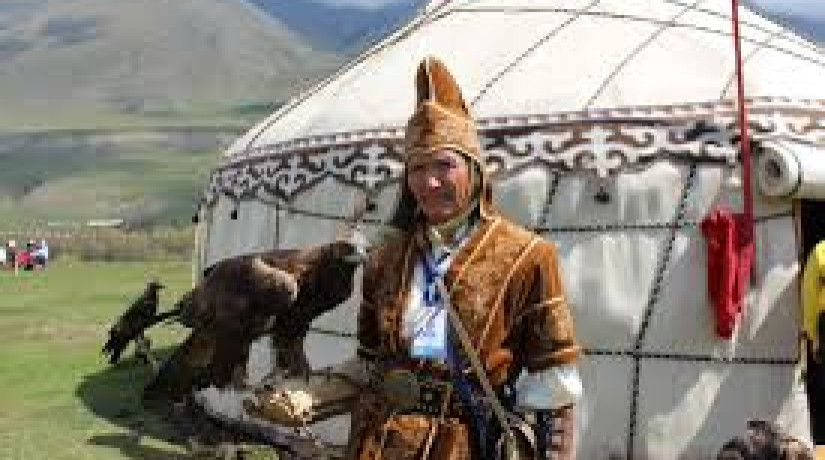Ancient DNA Analysis Sheds Light on Nomadic Scythian Populations
 29 Марта 2021
29 Марта 2021
 1242
1242
 Культура
Культура

Almaty. March 29. Information Center - Populations of Iron Age nomads living in Central Asia formed through a number of admixture events, a new ancient DNA analysis has found, Genome Web reports.
Scythians — a number of nomadic cattle-breeding cultures living across the Eurasian steppes — arose during the Iron Age. But little is known about their origin or how they are related to one another due to their lack of written records and contradictory information from other groups' written histories.
To examine the genetic history of Scythians, Leyla Djansugurova from the Institute of General Genetics and Cytology in Kazakhstan and her colleagues generated genome-wide targeted sequencing data from more than 110 ancient individuals from archeological sites across the Central Asian steppes dating back to the first millennia BC and AD, as well as array genotyping data for almost 100 present-day Kazakh individuals. As they reported on Friday in Science Advances, they found the Scythians were genetically heterogenous and shaped through various admixture events before their later decline.
"It seems to me, the term 'Scythians' united different populations who lived on a vast territory, but once had a common origin and had similar features [in terms of] economic structure and culture," Djansugurova said in an email.
She and her colleagues used an in-solution DNA capture approach to generate genome-wide data for 111 ancient individuals who hailed from 39 different sites in what are now Kazakhstan, Kyrgyzstan, and Russia, and one sample from Hungary. The ancient individuals lived between the eighth century BC and fourth century AD.
At the same time, they used SNP chips to analyze samples from 96 modern Kazakh individuals who had tribal affiliations with the three major Kazakh hordes.
Both principal component analysis and an analysis with the Admixture tool highlighted a demographic shift that took place among Kazakh Steppe populations between the Bronze and Iron Ages. Samples from the steppe from the Middle and Late Bronze Age were genetically homogenous, but those from the Iron Age exhibited additional influence from eastern Eurasian and southern populations related to Neolithic Iranians and Mesolithic Caucasus hunter-gatherers.
Through additional modeling, the researchers found that Middle and Late Bronze Age steppe ancestry could account for the western Eurasian ancestry found among Iron Age Scythians, but that their eastern Eurasian ancestry component was more complex.
Instead, they found that Iron Age Scythians also included ancestry components from Late Bronze Age herders from Khovsgol in northern Mongolia, in addition to a small proportion of ancestry from populations in the southern Caucasus/Iran or Turan. That small proportion varies from negligible to about 20 percent by time and geographic location.
Using admixture analyses, the researchers estimated that the main Scythian gene pools became established between 1,500 BC and 1,000 BC.
Meanwhile, the Sarmatians, another nomadic population that later replaced the Scythians around the second century BC, likely descended from a related, though different Late Bronze Age gene pool. They also had an increased proportion of Iranian ancestry, but less Khovsgol-linked ancestry. Additionally, beginning in the first millennium AD, the researchers further noted an increase in eastern Eurasian ancestry, which they attributed to the spread of eastern nomadic empires.
Present-day Kazakh populations — which they estimated established themselves between 1341 and 1544 AD — are relatively genetically homogenous compared to the Iron Age and some later populations, they found, and differ from the previous gene pools of the region.
This genetic homogeneity is likely due to the Kazakh custom of Zheti-ata that has been followed strictly for 400 years that discourages marriages within seven generations, according to Djansugurova, while the ethnogenetic change likely reflects events from the early Middle Ages as well as the Tatar-Mongol invasion of Genghis Khan. To investigate this further, she and her colleagues have begun to collect archaeological materials from the early Middle Ages, she said.
ru В Казахстане утвердили правила государственной поддержки креативной индустрии
ru На 15,1% выросли расходы бюджета на социально-трудовую сферу в 2026
ru Введены временные санитарные меры в отношении некоторых наименований чая
ru Принят новый закон о лицензировании детских лагерей
ru Молочно-товарную ферму на 1200 голов построят в Алматинской области
ru Глава государства провел рабочее совещание по Парламентской реформе
ru По итогам закупа лекарств на 2025 год сэкономлено более 85
ru Размеры пенсий и пособий увеличены в Казахстане
ru С начала зимнего сезона из Астаны вывезли более 1,6 млн
ru Смертность от рака в Казахстане за пять лет снизилась на
ru В 2025 году скорая помощь обслужила 7,4 млн вызовов
ru Подозреваемый в особо крупном мошенничестве экстрадирован из России
ru В Казахстане запускается система маркирования древесины
ru Утверждена региональная квота приема кандасов и переселенцев на 2026 год
ru На площади Абая пройдет двухдневный праздничный концерт «Кел, жаңа жыл!»
ru Гололед на дорогах: МВД обратилось к казахстанцам
ru В Алматинской области закуплено 490 единиц сельхозтехники
ru В Караганде ищут идеи для роботов-спасателей
ru Чем в Казахстане заменяют соль на дорогах
ru На сколько будут увеличены пенсии и пособия в Казахстане в
ru В Алматы стартует проект беспилотной доставки
ru В Астане стартует проект беспилотного такси
ru Более 700 астанчан приняли участие в новогоднем забеге
ru Президент утвердил концепцию развития АНК до 2030 года
ru На что тратят бюджетные деньги в Карагандинской области
ru Карагандинский стартап 4SELL.ai намерен покорить рынки ОАЭ и США
ru Более 1 370 проверок провели социнспекторы с начала года
ru Сенат одобрил поправки об усилении правовой защиты медицинских работников
ru АФМ выявлена схема хищения имущества АО «Qarmet» на 1,8 млрд

 +77772555856
+77772555856
 Написать нам
Написать нам












